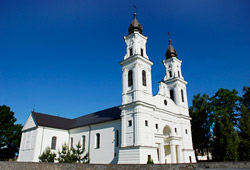Basilica of St Michael
The basilica is located in a level place between the city centre and the Šešupė River. Its main, eastern façade looks onto an intersection. The monastery is just north of the church. The architecture of the two-tower, three-nave basilica includes classicist and neo-baroque elements. The floor plan is cruciform, with a straight apse and towers that do not entirely fit in with the overall flow of the structure. Between the towers is an open-air foyer. Another vestibule by the northern sacristy upsets the symmetry of the building.
The central nave and its cylindrical vault dominate the church’s simple yet solemn interior. The nave is bordered by a wide moulded frieze and a protruding cornice. The church contains six neo-baroque altars.
The remains of Blessed Jurgis Matulaitis rest in a chapel bearing his name. Formerly known as Sacred Heart Chapel, it was built in 1902. The first level of the altar scene presents a painting of Blessed Jurgis Matulaitis by the artist Vytautas Ciplijauskas. The holy archbishop is depicted standing full-length with his episcopal regalia. An abstract sarcophagus construction of stone and copper forms the immediate backdrop to the altar. It features a central relief with the archbishop’s coat of arms, regalia and the phrase “Vince malum in bono” (Latin for “Overcome evil with good”). More than a dozen votive offerings of various shapes now hang beside the sarcophagus containing the relics of the Blessed. The upper level of the altar scene contains an image of St George painted in 1926 by T. Kulakauskas.
The altar of St Anthony of Padua, at the end of the right lateral nave, contains a painting of the Blessed Virgin Mary and the Child Jesus that until 1772 adorned the main altar. Associated with extraordinary graces, the picture was an object of special veneration until at least the middle of the 19th century. This image of Mary is known as “Our Lady of Vaizbūniškis”, because the countess who donated it to the church had previously kept it in the chapel of her estate at Vaizbūniškis. The painting’s yellow sheet-metal cover reflects the amazing metalworking skills of its creator, who has depicted clothing for the Blessed Virgin and the Child Jesus as well as crowns, hallows and other artistic details.








